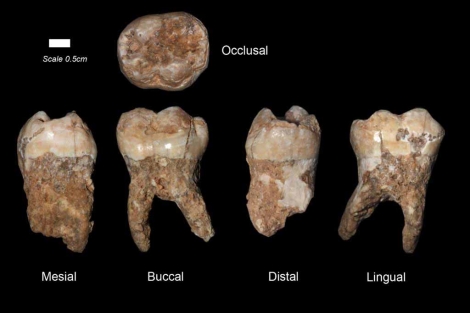Aunque en la publicación se es algo más cauto, en la prensa ha salido publicado con gran profusión que estos dientes tendrían 400.000 años y podrían ser de Homo sapiens, lo que podría cambiar el conocimiento que tenemos de los primeros pasos de la evolución de nuestra especie. Hasta el momento, la teoría más aceptada es la que Homo sapiens evoluciono en África, para luego migrar al resto de Europa. Con este nuevo descubrimiento, el escenario podría o no cambiar algo. El origen podría ser en el proximo oriente, o que la evolución en África fue anterior de lo que suponíamos hasta el momento. Lo que tendríamos registrado en Israel sería la primera ola migratora, unos cientos de miles de años antes de lo que conocíamos hasta el momento. De todas maneras el escenario que se presente es excitante, por qué quizás los humanos modernos no fueron africanos, futuros estudios nos lo aclararán.
Os adjuntamos el resumen original:
This study presents a description and comparative analysis of Middle Pleistocene permanent and deciduous teeth from the site of Qesem Cave (Israel). All of the human fossils are assigned to the Acheulo-Yabrudian Cultural Complex (AYCC) of the late Lower Paleolithic. The Middle Pleistocene age of the Qesem teeth (400–200 ka) places them chronologically earlier than the bulk of fossil hominin specimens previously known from southwest Asia. Three permanent mandibular teeth (C1-P4) were found in close proximity in the lower part of the stratigraphic sequence. The small metric dimensions of the crowns indicate a considerable degree of dental reduction although the roots are long and robust. In contrast, three isolated permanent maxillary teeth (I2, C1, and M3) and two isolated deciduous teeth that were found within the upper part of the sequence are much larger and show some plesiomorphous traits similar to those of the Skhul/Qafzeh specimens. Although none of the Qesem teeth shows a suite of Neanderthal characters, a few traits may suggest some affinities with members of the Neanderthal evolutionary lineage. However, the balance of the evidence suggests a closer similarity with the Skhul/Qafzeh dental material, although many of these resemblances likely represent plesiomorphous features. Am J Phys Anthropol, 2011.
Os adjuntamos el resumen original:
This study presents a description and comparative analysis of Middle Pleistocene permanent and deciduous teeth from the site of Qesem Cave (Israel). All of the human fossils are assigned to the Acheulo-Yabrudian Cultural Complex (AYCC) of the late Lower Paleolithic. The Middle Pleistocene age of the Qesem teeth (400–200 ka) places them chronologically earlier than the bulk of fossil hominin specimens previously known from southwest Asia. Three permanent mandibular teeth (C1-P4) were found in close proximity in the lower part of the stratigraphic sequence. The small metric dimensions of the crowns indicate a considerable degree of dental reduction although the roots are long and robust. In contrast, three isolated permanent maxillary teeth (I2, C1, and M3) and two isolated deciduous teeth that were found within the upper part of the sequence are much larger and show some plesiomorphous traits similar to those of the Skhul/Qafzeh specimens. Although none of the Qesem teeth shows a suite of Neanderthal characters, a few traits may suggest some affinities with members of the Neanderthal evolutionary lineage. However, the balance of the evidence suggests a closer similarity with the Skhul/Qafzeh dental material, although many of these resemblances likely represent plesiomorphous features. Am J Phys Anthropol, 2011.
LUGAR



















